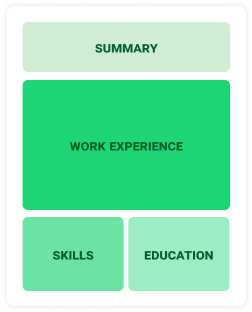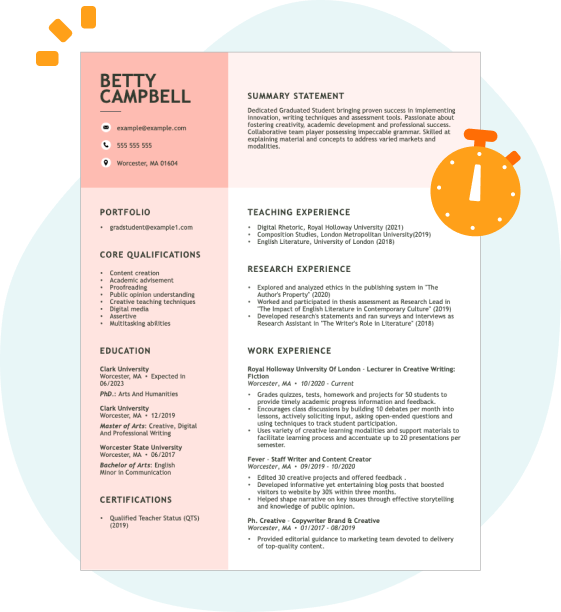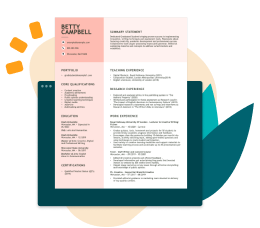Hard skills include skill in coding systems, knowledge of ICD-10-CM and CPT coding guidelines, and the ability to analyze medical records for accurate risk adjustment.
Popular Risk Adjustment Coder Resume Examples
Check out our top risk adjustment coder resume examples that emphasize key skills such as coding accuracy, analytical thinking, and regulatory knowledge. These examples will help you effectively showcase your expertise and achievements in the field.
Ready to build your own impressive resume? Our Resume Builder offers user-friendly templates specifically designed for coding professionals, making it simple to highlight your strengths.
Entry-level risk adjustment coder resume
This entry-level resume effectively highlights the job seeker's expertise in coding accuracy and compliance, showcasing strong results such as a 25% reduction in errors. New professionals must convey their coding skills and relevant certifications to attract potential employers, even if they have limited direct work experience.
Mid-career risk adjustment coder resume
This resume effectively illustrates key qualifications through quantifiable achievements and a clear progression in coding roles. The applicant's expertise in risk adjustment and compliance positions them as a capable professional ready for advanced responsibilities and leadership opportunities.
Experienced risk adjustment coder resume
This resume's work experience section demonstrates the applicant's extensive expertise as a risk adjustment coder, highlighting achievements such as improving risk scores by 15% and training junior coders. The clear formatting improves readability, making it easy for hiring managers to identify key accomplishments quickly.
Resume Template—Easy to Copy & Paste
John Brown
Parkview, MO 64165
(555)555-5555
John.Brown@example.com
Professional Summary
Experienced Risk Adjustment Coder with expertise in ICD-10 & CPT coding, improving accuracy, and reducing errors. Fluent in Spanish with a proven track record in healthcare analytics. Certified CRC and CPC from AAPC.
Work History
Risk Adjustment Coder
MedData Solutions - Parkview, MO
November 2023 - October 2025
- Analyzed 1500+ patient records quarterly.
- Improved risk score accuracy by 15%.
- Trained 5 junior coders on CMS guidelines.
Medical Coding Specialist
HealthCode Inc. - Parkview, MO
November 2021 - October 2023
- Reviewed and coded 1200 documents monthly.
- Reduced coding errors by 20%.
- Collaborated with 10 physicians for accurate coding.
Healthcare Data Analyst
PrimeHealth Analytics - St. Louis, MO
November 2020 - October 2021
- Analyzed health data for 3000 patients.
- Increased data accuracy by 10%.
- Generated monthly reports for 4 departments.
Languages
- Spanish - Beginner (A1)
- French - Intermediate (B1)
- German - Beginner (A1)
Skills
- ICD-10 Coding
- CPT Coding
- Risk Adjustment
- CMS HCC Coding
- Medical Terminology
- Data Analysis
- EHR Proficiency
- Quality Assurance
Certifications
- Certified Risk Adjustment Coder (CRC) - AAPC
- Certified Professional Coder (CPC) - AAPC
Education
Master's Degree Health Informatics
University of Florida Gainesville, Florida
May 2020
Bachelor's Degree Biology
University of Miami Miami, Florida
May 2018
How to Write a Risk Adjustment Coder Resume Summary
Your resume summary is the first impression you make on hiring managers, making it essential to craft it carefully. As a risk adjustment coder, you should highlight your analytical skills and attention to detail, showcasing your ability to ensure accurate coding for optimal reimbursement.
This profession demands an understanding of clinical documentation and regulatory guidelines, emphasizing your expertise in risk adjustment methodologies. By focusing on relevant accomplishments and qualifications, you can effectively communicate your value to prospective employers.
To further illustrate what works in this section, consider the following examples that will guide you in writing a compelling resume summary:
Weak resume summary
I am an experienced risk adjustment coder with a solid background in healthcare. I seek a position where I can use my skills and contribute to the company. A job that values teamwork and growth would be perfect for me. I believe I can add value to your team if given a chance.
- Lacks specific examples of coding experience or achievements, making it vague
- Focuses on personal desires rather than highlighting what the job seeker brings to the employer
- Uses generic phrases like 'solid background' without detailing relevant skills or contributions
Strong resume summary
Detail-oriented risk adjustment coder with over 6 years of experience in healthcare coding and compliance. Successfully improved coding accuracy by 20% through rigorous audits and training for clinical staff, resulting in improved reimbursement rates. Proficient in ICD-10, CPT coding, and using electronic health record systems to ensure precise documentation.
- Begins with a clear indication of experience level and specific industry focus
- Highlights a quantifiable achievement that illustrates the job seeker's impact on revenue and accuracy
- Showcases relevant technical skills that align with the requirements of risk adjustment coding positions
PRO TIP
Showcasing Your Work Experience
The work experience section is important for your resume as a risk adjustment coder, and it will contain the bulk of your content. Good resume templates always emphasize this area to help you showcase your relevant experience effectively.
This section should be organized in reverse-chronological order, listing your previous positions. Use bullet points to highlight specific achievements and contributions in each role to make your accomplishments clear.
To further guide you, we’ll provide examples that illustrate effective entries for risk adjustment coders. These examples will demonstrate what works well and what pitfalls to avoid:
Risk Adjustment Coder
HealthCare Solutions – Dallas, TX
- Reviewed medical records
- Entered codes into the system
- Collaborated with healthcare providers
- Ensured compliance with regulations
- No specific details about achievements or outcomes
- Bullet points lack depth and focus on everyday tasks rather than impacts
- Does not highlight any measurable results or contributions to the organization
Risk Adjustment Coder
HealthFirst Medical Group – Orlando, FL
March 2020 - Current
- Review and analyze patient medical records to ensure accurate risk adjustment coding, improving reimbursement accuracy by 30%
- Collaborate with healthcare providers to identify documentation gaps, leading to a 20% increase in risk scores over one year
- Conduct training sessions for staff on best coding practices, improving overall coding compliance rates by 15%
- Uses strong action verbs to clearly convey achievements and responsibilities
- Incorporates specific metrics to demonstrate the impact of the applicant’s efforts
- Highlights collaboration and training as essential skills relevant to the role
While your resume summary and work experience are important, don’t overlook the importance of other sections. Each part of your resume plays a role in showcasing your qualifications. For more detailed guidance, be sure to check out our comprehensive guide on how to write a resume.
Top Skills to Include on Your Resume
A skills section is important for any resume as it highlights your qualifications at a glance. It allows employers to quickly identify if you possess the abilities needed for the role, making your application stand out.
Employers seek well-rounded professionals who combine strong technical expertise with valuable interpersonal abilities. When crafting your resume, highlight both your hard and soft skills to present a complete picture of your professional capabilities.
Soft skills involve attention to detail, critical thinking, and effective communication, which are essential for ensuring precision in coding and fostering collaboration within healthcare teams.
Selecting the right resume skills is important for aligning with what employers expect from applicants. Many organizations use automated systems that filter out applicants lacking essential qualifications, so it's necessary to highlight relevant abilities earlier in your application.
To effectively showcase your skills, carefully examine job postings related to the positions you seek. These listings often provide valuable insights into which competencies are most desirable, helping tailor your resume for both recruiters and ATS systems alike.
PRO TIP
10 skills that appear on successful risk adjustment coder resumes
Highlighting essential skills in your resume can significantly capture the attention of recruiters searching for risk adjustment coders. Our resume examples showcase these in-demand qualifications, helping you to apply with confidence and professionalism.
By the way, consider incorporating relevant skills from the following list that align with your experience and job requirements:
Attention to detail
Analytical thinking
Skills in coding software
Knowledge of ICD-10-CM codes
Ability to work under pressure
Strong communication skills
Team collaboration
Time management
Problem-solving abilities
Familiarity with health insurance guidelines
Based on analysis of 5,000+ insurance professional resumes from 2023-2024
Resume Format Examples
Selecting the appropriate resume format is important for a risk adjustment coder, as it effectively showcases your coding expertise, relevant experience, and professional growth in a clear and organized manner.
Functional
Focuses on skills rather than previous jobs

Best for:
Recent graduates and career changers with up to two years of experience
Combination
Balances skills and work history equally

Best for:
Mid-career professionals seeking to demonstrate key skills and growth potential
Chronological
Emphasizes work history in reverse order

Best for:
Seasoned experts in risk assessment with leadership experience
Frequently Asked Questions
Should I include a cover letter with my risk adjustment coder resume?
Absolutely, including a cover letter is a great way to differentiate yourself from other applicants. It allows you to highlight your unique skills and experiences while demonstrating your enthusiasm for the position. For tips on crafting an effective cover letter, consider checking out our comprehensive guide on how to write a cover letter or using our Cover Letter Generator for quick assistance.
Can I use a resume if I’m applying internationally, or do I need a CV?
Use a CV for most international job applications, as it provides a detailed professional history. Explore our CV examples to understand global formatting standards and learn effective writing techniques tailored for international roles. For guidance on structuring your CV effectively, check out our comprehensive guide on how to write a CV.
What soft skills are important for risk adjustment coders?
Soft skills including attention to detail, communication, and collaboration play a important role for risk adjustment coders. These interpersonal skills foster effective interactions with healthcare providers and ensure accurate coding, ultimately leading to improved patient care and streamlined processes.
I’m transitioning from another field. How should I highlight my experience?
Highlight your transferable skills, such as analytical thinking, attention to detail, and effective communication. Even if you lack direct coding experience, these abilities showcase your potential impact in risk adjustment roles. Use concrete examples from past jobs to illustrate how these strengths relate to coding responsibilities and improve overall patient outcomes.
Should I use a cover letter template?
Yes, using a cover letter template tailored for risk adjustment coders improves your ability to present information clearly and logically. It allows you to highlight essential skills such as coding accuracy, compliance expertise, and data analysis achievements effectively, which are critical to impressing hiring managers.
How do I write a resume with no experience?
If you're seeking a risk adjustment coder position but lack formal experience, don't worry. Highlight relevant coursework, certifications, and any internships or volunteer roles that demonstrate your analytical skills. Emphasize your attention to detail and ability to learn quickly on your resume with no experience. Your passion for healthcare coding will shine through, making you a compelling job seeker for employers.







